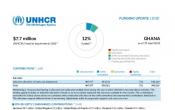Ghana
Operation: Ghana
Location
{"longitude":-1,"latitude":8,"zoom_level":7,"iso_codes":"'GHA'"}
By clicking on the icons on the map, additional information is displayed.
The boundaries and names shown and the designations used on this map do not imply official endorsement or acceptance by the United Nations.
Key Figures
| 2020 planning figures | |
| 5,300 | children enrolled in primary education |
| 650 | people of concern will receive resident permits |
| 560 | people of concern provided with entrepreneurship/business training |
| 130 | people of concern trained on SGBV prevention and response |
| 110 | children registered and for whom documentation is issued under regular birth registration procedure |
| 2018 year-end results | |
| 530 | refugee households received cash transfers through mobile money |
| 300 | Ivorian refugees (101 households) were assisted to return to their country of origin |
| 200 | camp-based and urban people of concern were enrolled in senior high school |
Latest Updates
People of Concern
2%
Increase in
2019
2019
| 2019 | 13,463 |
| 2018 | 13,216 |
| 2017 | 13,470 |

[["Refugees",11948],["Asylum-seekers",1515]]
Loading ...
Ghana
< Back
2019
{"categories":[2015,2016,2017,2018,2019,2020],"budget":[10.948861362,9.44475501,8.87886663,8.08587775,7.69708201,7.88681904],"expenditure":[5.30940838,5.07294779,5.39249998,4.42170778,5.73379425,null]}
{"categories":[2015,2016,2017,2018,2019,2020],"p1":[10.948861362,9.44475501,8.87886663,8.08587775,7.69708201,7.88681904],"p2":[null,null,null,null,null,null],"p3":[null,null,null,null,null,null],"p4":[null,null,null,null,null,null]}
{"categories":[2015,2016,2017,2018,2019,2020],"p1":[5.30940838,5.07294779,5.39249998,4.42170778,5.73379425,null],"p2":[null,null,null,null,null,null],"p3":[null,null,null,null,null,null],"p4":[null,null,null,null,null,null]}
Loading ...
CHOOSE A YEAR
- 2015
- 2016
- 2017
- 2018
- 2019
- 2020
Year-end Overview
Plan Overview
Working environment
The operational environment in Ghana is expected to remain stable in 2019. The estimated number of people of concern to UNHCR in Ghana in 2019 stands at close to 12,000 people. With positive economic developments in the country, it has increasingly become a country of destination for asylum-seekers in the region,The United Nations Sustainable Development Partnership (UNSDP) 2018 – 2022 signed with the Ghana Government in July 2018 sets out strategic priorities for the partnership between the UN and the Government of Ghana. It targets support towards the implementation of national development strategies and the achievement of global development, human rights and environment commitments.
The Ministry of Interior is the key policy-maker regarding people of concern to UNHCR in Ghana. UNHCR will continue to work with Ghana Refugee Board (GRB), main interlocutor within the Ministry, to strengthen partnerships with various government stakeholders, as well as with other UN agencies, development partners, civil society and the private sector.
UNHCR’s operational focus in Ghana has shifted from emergency assistance to the search for durable solutions. This shift has also brought challenges among the refugee communities such as: discontent on withdrawal of food and other emergency assistance, lack of willingness to engage on durable solutions other than resettlement, and tensions with host communities due to accusations of food theft.
UNHCR continues to work closely and cooperate with the Government of Ghana and neighbouring governments in an effort to ensure a collaborative and consistent approach to asylum across the region. The strategic objectives of the multi-year multi-partner (MYMP) strategy developed in 2016 include voluntary repatriation as the most desirable solution for refugees and local integration for those unable or unwilling to return to their country based on valid protection reasons. Refugees with heightened protection needs and serious medical conditions not treatable in Ghana will be identified for resettlement.
As part of the MYMP approach, UNHCR seeks to leverage the regional framework applicable in the Economic Community of West African States (ECOWAS). UNHCR has developed a rights-based solution framework in West Africa for protracted refugees opting for local integration in their asylum countries, supporting long-term residency coupled with the issuance of nationality documents and/or naturalization as appropriate durable solutions. This framework was strengthened by the Abidjan Declaration on the Eradication of Statelessness in February 2015. The Conclusions and Recommendations of the ECOWAS Ministerial Conference on Statelessness emphasize the particular risk of statelessness for protracted refugees, recommending measures to facilitate the (re)acquisition of nationality.
Key priorities
In 2019, UNHCR will focus on:- civil registration, individual documentation, SGBV response, access to health and education for primary school-aged children, child protection, and durable solutions;
- consolidating the mainstreaming of basic and essential services into the national systems and empowering refugees to be self-sufficient in conjunction with strengthened advocacy to ensure that people of concern are able to access national protection services;
- facilitation of voluntary return of Ivorian refugees, including the provision of better information on conditions in areas of return through go-and-see and come-and-tell visits and on the return package;
- identifying refugees with heightened protection risks and in need of resettlement, and submitting the cases of identified people for resettlement through the regional office;
- achieving an agreement with the Government concerning legal local integration as a durable solution for refugees in protracted situations, particularly, the acquisition of long term residence permits for those opting for it;
- provision of individual documentation, including birth certificates for children born in Ghana, as well as ensuring people of concern have access to basic services and banking;
- advocating for the Government of Ghana to accede to the conventions on Statelessness;
- strengthening SGBV procedures and coordination mechanisms further with the increased involvement of State actors.




















